How To Recognise Computer Expansion Cards
HOME > Computers > Expansion
People sometimes marvel at my ability to recognise a particular
type of computer add-on card and tell them what kind of computer
it was designed to plug into.
This page is an attempt to show a few examples, to help others
to spot classic computer parts amongst the dross.
Introduction
 Here's an example of a classic computer board, compared to two
modern PC add-on cards.
The big card is a disk controller from that most classic of
computers, the PDP-11; the card at top left is a network card for
a 16-bit
ISA
bus slot, and the card at top right is a
PCI
sound card.
The 10 megabit Ethernet cards are being thrown out by IT departments
all over the place.
PCI sound cards are available at computer fairs for a few pounds.
PDP-11 boards are irreplaceable examples of late 1970s technology,
and should be conserved with great care.
Here's an example of a classic computer board, compared to two
modern PC add-on cards.
The big card is a disk controller from that most classic of
computers, the PDP-11; the card at top left is a network card for
a 16-bit
ISA
bus slot, and the card at top right is a
PCI
sound card.
The 10 megabit Ethernet cards are being thrown out by IT departments
all over the place.
PCI sound cards are available at computer fairs for a few pounds.
PDP-11 boards are irreplaceable examples of late 1970s technology,
and should be conserved with great care.
 Now let's compare memory boards.
The large board here is a 32k byte memory board for a PDP-11;
the smaller board is a 256M byte
DIMM
for a modern PC.
Note the metal stiffener (at the bottom of the photo) and the lock
and eject levers on the much more substantial PDP-11 board.
The DIMM standard places the lock and eject levers on the PC
motherboard, and has no need of metal stiffeners.
The PDP-11 board holds 32768 bytes, while the DIMM holds
268435456 bytes, a factor of 8192 bigger.
Now let's compare memory boards.
The large board here is a 32k byte memory board for a PDP-11;
the smaller board is a 256M byte
DIMM
for a modern PC.
Note the metal stiffener (at the bottom of the photo) and the lock
and eject levers on the much more substantial PDP-11 board.
The DIMM standard places the lock and eject levers on the PC
motherboard, and has no need of metal stiffeners.
The PDP-11 board holds 32768 bytes, while the DIMM holds
268435456 bytes, a factor of 8192 bigger.
So far, you might be drawing the conclusion that large boards are old,
classic and good, while small boards are new, modern and rubbish.
This is of course absolutely correct.
The Eight-Bit Generation
 Here's a rare one.
This is the board inside the 16k byte expansion module for the
Jupiter Ace.
The Jupiter Ace was a spin-off from the Sinclair ZX81 and
ZX Spectrum, but instead of using a
BASIC
interpreter, it had a FORTH language system.
Not many were sold.
Note the eight 4116
DRAM
chips, in 16-pin
DIL
packages.
The chips have date codes “8232”, which means they were
made in the 32nd week of 1982.
Here's a rare one.
This is the board inside the 16k byte expansion module for the
Jupiter Ace.
The Jupiter Ace was a spin-off from the Sinclair ZX81 and
ZX Spectrum, but instead of using a
BASIC
interpreter, it had a FORTH language system.
Not many were sold.
Note the eight 4116
DRAM
chips, in 16-pin
DIL
packages.
The chips have date codes “8232”, which means they were
made in the 32nd week of 1982.
 This memory board was produced by Watford Electronics in the early
1980s.
It was designed to be used with an expansion motherboard that could
be connected to several machines of that era.
I bought one and hard-wired it to my
Compukit UK101.
It holds 8k bytes (8192 bytes) of memory, in 16 2114 static RAM chips.
Once again, the RAM chips are in DIL packages (18 pin) and in this
case are in sockets.
This memory board was produced by Watford Electronics in the early
1980s.
It was designed to be used with an expansion motherboard that could
be connected to several machines of that era.
I bought one and hard-wired it to my
Compukit UK101.
It holds 8k bytes (8192 bytes) of memory, in 16 2114 static RAM chips.
Once again, the RAM chips are in DIL packages (18 pin) and in this
case are in sockets.
Coming soon: Apple ][ and Apple /// expansion boards, BBC Micro
upgrades and Sinclair RAM packs.
The Acorn Archimedes
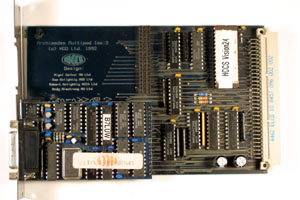 This expansion board is a video add-on Podule for an Acorn
Archimedes.
Note the DIN 41612 connector on the right-hand side, and the Acorn
mounting bracket on the left.
This expansion board is a video add-on Podule for an Acorn
Archimedes.
Note the DIN 41612 connector on the right-hand side, and the Acorn
mounting bracket on the left.
The IBM-Compatible PC
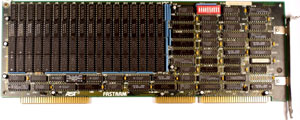 Although this board looks like a normal IBM PC expansion card
(ISA bus),
it's not.
It's actually an AST Fastram board, designed for use in special
RAM slots in AST 286 motherboards.
Note the additional gold-plated edge connector on the bottom
left-hand side of the board.
The RAM chips are 256k by 1-bit DRAMs, so the total capacity is
a staggering 2Mbytes.
Only the first 512kbytes are soldered in; the rest are in sockets and
have been added as upgrades.
Although this board looks like a normal IBM PC expansion card
(ISA bus),
it's not.
It's actually an AST Fastram board, designed for use in special
RAM slots in AST 286 motherboards.
Note the additional gold-plated edge connector on the bottom
left-hand side of the board.
The RAM chips are 256k by 1-bit DRAMs, so the total capacity is
a staggering 2Mbytes.
Only the first 512kbytes are soldered in; the rest are in sockets and
have been added as upgrades.
DEC TurboChannel boards
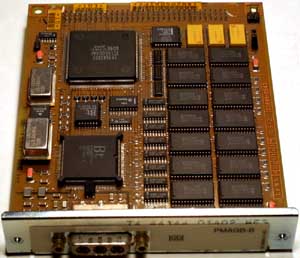
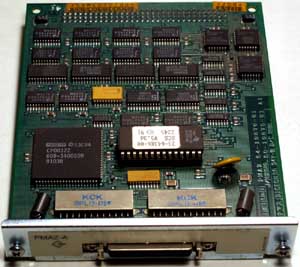 Two boards from
DEC
that can be used with either the MIPS-based DEC 5000 or the
DEC 3000 with an Alpha processor.
Two boards from
DEC
that can be used with either the MIPS-based DEC 5000 or the
DEC 3000 with an Alpha processor.
Sun SBus boards

 First, a
Sun
SPARC
CPU
board, which is actually an MBus card.
Note the heatsink on top of the CPU chip and the power regulator
module on the right-hand end of the board.
First, a
Sun
SPARC
CPU
board, which is actually an MBus card.
Note the heatsink on top of the CPU chip and the power regulator
module on the right-hand end of the board.
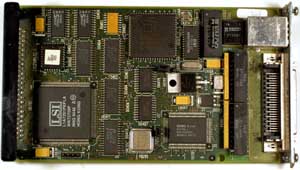
 A classic SBus card, the combination SCSI and Ethernet card.
The black plastic handle (for removing the card) is on the left,
and the metal faceplate with the two connectors is on the right.
The Ethernet on this card uses the twisted-pair RJ45 connector,
but is only standard Ethernet at 10MHz.
A much more sought-after card is the Quad Fast Ethernet,
which has four RJ45 connectors and works at 100MHz
A classic SBus card, the combination SCSI and Ethernet card.
The black plastic handle (for removing the card) is on the left,
and the metal faceplate with the two connectors is on the right.
The Ethernet on this card uses the twisted-pair RJ45 connector,
but is only standard Ethernet at 10MHz.
A much more sought-after card is the Quad Fast Ethernet,
which has four RJ45 connectors and works at 100MHz
Networking Devices
 It's sometimes important to recognise when a board is not a
computer expansion card at all, but an add-on to something else.
This is a two-line
ISDN
interface for a small router.
On the underside, it has a DIN 41612 connector, a sure sign that this
is no PC add-on card.
The two small daughter boards (or should that be grand-daughter)
plug in to the main board.
All the major chips are embedded-systems versions of the 68000.
It's sometimes important to recognise when a board is not a
computer expansion card at all, but an add-on to something else.
This is a two-line
ISDN
interface for a small router.
On the underside, it has a DIN 41612 connector, a sure sign that this
is no PC add-on card.
The two small daughter boards (or should that be grand-daughter)
plug in to the main board.
All the major chips are embedded-systems versions of the 68000.
 Here's an example of a classic computer board, compared to two
modern PC add-on cards.
The big card is a disk controller from that most classic of
computers, the PDP-11; the card at top left is a network card for
a 16-bit
ISA
bus slot, and the card at top right is a
PCI
sound card.
The 10 megabit Ethernet cards are being thrown out by IT departments
all over the place.
PCI sound cards are available at computer fairs for a few pounds.
PDP-11 boards are irreplaceable examples of late 1970s technology,
and should be conserved with great care.
Here's an example of a classic computer board, compared to two
modern PC add-on cards.
The big card is a disk controller from that most classic of
computers, the PDP-11; the card at top left is a network card for
a 16-bit
ISA
bus slot, and the card at top right is a
PCI
sound card.
The 10 megabit Ethernet cards are being thrown out by IT departments
all over the place.
PCI sound cards are available at computer fairs for a few pounds.
PDP-11 boards are irreplaceable examples of late 1970s technology,
and should be conserved with great care.
 Now let's compare memory boards.
The large board here is a 32k byte memory board for a PDP-11;
the smaller board is a 256M byte
DIMM
for a modern PC.
Note the metal stiffener (at the bottom of the photo) and the lock
and eject levers on the much more substantial PDP-11 board.
The DIMM standard places the lock and eject levers on the PC
motherboard, and has no need of metal stiffeners.
The PDP-11 board holds 32768 bytes, while the DIMM holds
268435456 bytes, a factor of 8192 bigger.
Now let's compare memory boards.
The large board here is a 32k byte memory board for a PDP-11;
the smaller board is a 256M byte
DIMM
for a modern PC.
Note the metal stiffener (at the bottom of the photo) and the lock
and eject levers on the much more substantial PDP-11 board.
The DIMM standard places the lock and eject levers on the PC
motherboard, and has no need of metal stiffeners.
The PDP-11 board holds 32768 bytes, while the DIMM holds
268435456 bytes, a factor of 8192 bigger.
 Here's a rare one.
This is the board inside the 16k byte expansion module for the
Jupiter Ace.
The Jupiter Ace was a spin-off from the Sinclair ZX81 and
ZX Spectrum, but instead of using a
BASIC
interpreter, it had a FORTH language system.
Not many were sold.
Note the eight 4116
DRAM
chips, in 16-pin
DIL
packages.
The chips have date codes “8232”, which means they were
made in the 32nd week of 1982.
Here's a rare one.
This is the board inside the 16k byte expansion module for the
Jupiter Ace.
The Jupiter Ace was a spin-off from the Sinclair ZX81 and
ZX Spectrum, but instead of using a
BASIC
interpreter, it had a FORTH language system.
Not many were sold.
Note the eight 4116
DRAM
chips, in 16-pin
DIL
packages.
The chips have date codes “8232”, which means they were
made in the 32nd week of 1982.
 This memory board was produced by Watford Electronics in the early
1980s.
It was designed to be used with an expansion motherboard that could
be connected to several machines of that era.
I bought one and hard-wired it to my
This memory board was produced by Watford Electronics in the early
1980s.
It was designed to be used with an expansion motherboard that could
be connected to several machines of that era.
I bought one and hard-wired it to my
 This expansion board is a video add-on Podule for an Acorn
Archimedes.
Note the DIN 41612 connector on the right-hand side, and the Acorn
mounting bracket on the left.
This expansion board is a video add-on Podule for an Acorn
Archimedes.
Note the DIN 41612 connector on the right-hand side, and the Acorn
mounting bracket on the left.
 Although this board looks like a normal IBM PC expansion card
(ISA bus),
it's not.
It's actually an AST Fastram board, designed for use in special
RAM slots in AST 286 motherboards.
Note the additional gold-plated edge connector on the bottom
left-hand side of the board.
The RAM chips are 256k by 1-bit DRAMs, so the total capacity is
a staggering 2Mbytes.
Only the first 512kbytes are soldered in; the rest are in sockets and
have been added as upgrades.
Although this board looks like a normal IBM PC expansion card
(ISA bus),
it's not.
It's actually an AST Fastram board, designed for use in special
RAM slots in AST 286 motherboards.
Note the additional gold-plated edge connector on the bottom
left-hand side of the board.
The RAM chips are 256k by 1-bit DRAMs, so the total capacity is
a staggering 2Mbytes.
Only the first 512kbytes are soldered in; the rest are in sockets and
have been added as upgrades.



 First, a
First, a

 A classic SBus card, the combination SCSI and Ethernet card.
The black plastic handle (for removing the card) is on the left,
and the metal faceplate with the two connectors is on the right.
The Ethernet on this card uses the twisted-pair RJ45 connector,
but is only standard Ethernet at 10MHz.
A much more sought-after card is the Quad Fast Ethernet,
which has four RJ45 connectors and works at 100MHz
A classic SBus card, the combination SCSI and Ethernet card.
The black plastic handle (for removing the card) is on the left,
and the metal faceplate with the two connectors is on the right.
The Ethernet on this card uses the twisted-pair RJ45 connector,
but is only standard Ethernet at 10MHz.
A much more sought-after card is the Quad Fast Ethernet,
which has four RJ45 connectors and works at 100MHz
 It's sometimes important to recognise when a board is not a
computer expansion card at all, but an add-on to something else.
This is a two-line
ISDN
interface for a small router.
On the underside, it has a DIN 41612 connector, a sure sign that this
is no PC add-on card.
The two small daughter boards (or should that be grand-daughter)
plug in to the main board.
All the major chips are embedded-systems versions of the 68000.
It's sometimes important to recognise when a board is not a
computer expansion card at all, but an add-on to something else.
This is a two-line
ISDN
interface for a small router.
On the underside, it has a DIN 41612 connector, a sure sign that this
is no PC add-on card.
The two small daughter boards (or should that be grand-daughter)
plug in to the main board.
All the major chips are embedded-systems versions of the 68000.